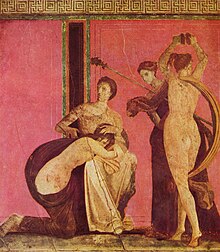Italian Art

The School of Athens
 Fresco from the Villa of the Mysteries. Pompeii, 80 BC
Fresco from the Villa of the Mysteries. Pompeii, 80 BCSince ancient times, Greeks, Etruscans and Celts have inhabited the south, center and north of the Italian peninsula respectively. The very numerous Rock Drawings in Valcamonica go back to 8,000 BC, and there are rich remains of Etruscan art from thousands of tombs, as well as rich remains from the Greek colonies at Paestum, Agrigento and elsewhere. Ancient Rome finally emerged as the dominant Italian and European power. The Roman remains in Italy are of extraordinary richness, from the grand Imperial monuments of Rome itself to the survival of exceptionally preserved ordinary buildings in Pompeii and neighboring sites. Following the fall of the Roman Empire, in the Middle Ages Italy, especially the north, remained an important center, not only of the Carolingian art and Ottonian art of the Holy Roman Emperors, but for the Byzantine art of Ravenna and other sites.
Italy was the main the center of artistic developments throughout the Renaissance (1300-1600), beginning with the Proto-Renaissance of Giotto and reaching a particular peak in the High Renaissance of Leonardo da Vinci, Michelangelo and Raphael, whose works inspired the later phase of the Renaissance, known as Mannerism. Italy retained its artistic dominance into the 17th century with the Baroque (1600-1750). Cultural tourism and Neoclassicism (1750-1850) became a major prop to an otherwise faltering economy. Both Baroque and Neoclassicism originated in Rome and were the last Italian-born styles that spread to all Western art. However, Italy maintained a presence in the international art scene from the mid-19th century onward, with movements such as the Macchiaioli, Futurism, Metaphysical, Novecento Italiano, Spatialism, Arte Povera, and Transavantgarde.
Italian art has influenced several major movements throughout the centuries and has produced several great artists, including painters, architects and sculptors. Today, Italy has an important place in the international art scene, with several major art galleries, museums and exhibitions; major artistic centres in the country include Rome, Florence, Venice, Milan, Turin, Genoa, Naples, Palermo, Lecce and other cities. Italy is home to 53 World Heritage Sites, the largest number of any country in the world.


